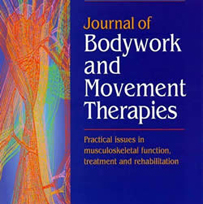Full Members: JBMT Subscription
Have you signed up for your free subscription to the Journal of Bodywork and Movement Therapy yet?
Full members with an active PAA membership have a subscription to JBMT included in your membership (lists are updated quarterly).
Follow this link for instructions on how to access your complimentary subscription to the Journal: JBMT registration instructions

Electromyographic evaluation of trunk core muscles during Pilates exercise on different supporting bases
Abstract
Objective
To evaluate the electromyographic (EMG) activity of the rectus abdominis (RA) and internal oblique (IO) muscles during Pilates exercise on different trunk supporting bases.
Methods
Sixteen female Pilates practitioners participated in the study. EMG of the RA and OI muscles was evaluated during the double leg stretch (DLS) exercise on three different supporting bases — mat, long box, and short box. Trunk stability varies according to the size and type of the base. To normalize the data, the RMS value (EMG) obtained during the DLS exercise was divided by the RMS value from the torque test — the maximal voluntary isometric contraction (MVIC) — and multiplied by 100 (%MVIC). One-way repeated-measured analysis of variance (ANOVA) and Bonferroni tests were used to compare data concerning the supporting bases and Student t-test regarding the muscles (p < 0.05).
Results
The comparison among the bases involving each muscle — RA or IO (p < 0.05) — showed significant difference (%MVIC) between the mat and the short box. No significant difference was observed between the muscles concerning the exercise on the mat (p = 0.9266), on the long box (p = 0.5113) and on the short box (p = 0.2972).
Conclusion
The short box increased the activity of the rectus abdominis and internal oblique muscles during exercise. The DLS exercise was able to challenge the stability of the trunk and thus recruit its stabilizer and mobilizer muscles at the same intensity.
Note: The complete article is available to read at the link above (login required for access).

Comments are closed.